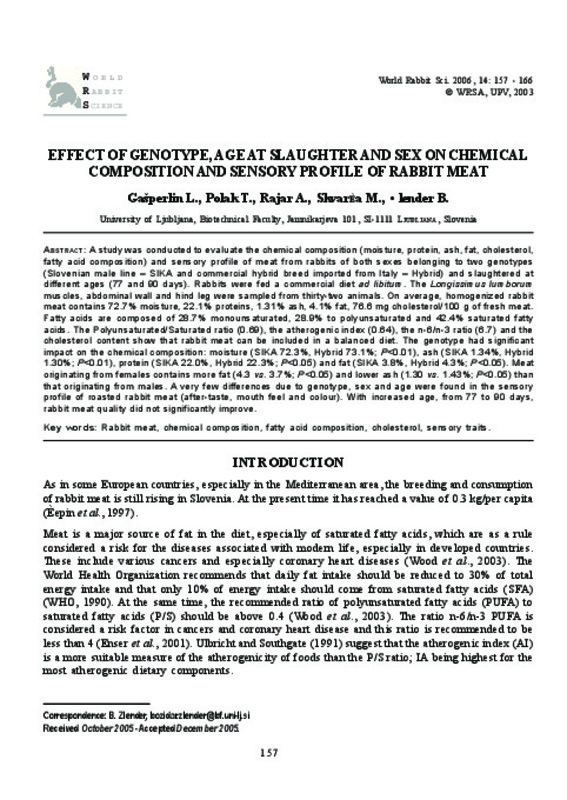JavaScript is disabled for your browser. Some features of this site may not work without it.
Buscar en RiuNet
Listar
Mi cuenta
Estadísticas
Ayuda RiuNet
Admin. UPV
Effect of genotype, age at slaughter and sex on chemical composition and sensory profile of rabbit meat
Mostrar el registro sencillo del ítem
Ficheros en el ítem
| dc.contributor.author | Gasperlin, L.
|
|
| dc.contributor.author | Polak, T.
|
|
| dc.contributor.author | Rajar, A.
|
|
| dc.contributor.author | Skvarèa, M.
|
|
| dc.contributor.author | Zlender, B.
|
|
| dc.date.accessioned | 2011-02-09T11:17:53Z | |
| dc.date.available | 2011-02-09T11:17:53Z | |
| dc.date.issued | 2006 | |
| dc.identifier.issn | 1257-5011 | |
| dc.identifier.uri | http://hdl.handle.net/10251/9592 | |
| dc.description.abstract | [EN] A study was conducted to evaluate the chemical composition (moisture, protein, ash, fat, cholesterol, fatty acid composition)and sensory profile of meat from rabbits of both sexes belonging to two genotypes (Slovenian male line - SIKA and commercial hybrid breed imported from Italy - Hybrid) and slaughtered at different ages (77 and 90 days). Rabbits were fed a commercial diet ad libitum. The Longissimus lumborum muscles, abdominal wall and hind leg were sampled from thirty-two animals. On average, homogenized rabbit meat contains 72.7% moisture, 22.1% proteins, 1.31% ash, 4.1% fat, 76.6 mg cholesterol/100 g of fresh meat. Fatty acids are composed of 28.7% monounsaturated, 28.9% to polyunsaturated and 42.4% saturated fatty acids. The Polyunsaturated/Saturated ratio(0.69), the atherogenic index (0.64), the n-6/n-3 ratio (6.7) and the cholesterol content show that rabbit meat can be included in a balanced diet. The genotype had significant impact on the chemical composition: moisture (SIKA 72.3%, Hybrid 73.1%; P<0.01), ash (SIKA 1.34%, Hybrid 1.30%; P<0.01), protein (SIKA 22.0%, Hybrid 22.3%; P<0.05) and fat (SIKA 3.8%, Hybrid 4.3%; P<0.05). Meat originating from females contains more fat (4.3 vs. 3.7%; P<0.05) and lower ash (1.30 vs. 1.43%; P<0.05) than that originating from males. A very few differences due to genotype, sex and age were found in the sensory profile of roasted rabbit meat (after-taste, mouth feel and colour). With increased age, from 77 to 90 days, rabbit meat quality did not significantly improve. Key words: Rabbit meat, chemical composition, fatty acid composition, cholesterol, sensory traits. | es_ES |
| dc.description.sponsorship | This research was financed by the Slovene Ministry of Education, Science and Sport (V4-0736-0481-02 project). We want to express our gratitude to Milica Kaè, Ph. D. for her valuable comments on an earlier draft of this paper. | |
| dc.language | Inglés | es_ES |
| dc.publisher | World Rabbit Science. ICTA. UPV | es_ES |
| dc.relation.ispartof | World Rabbit Science | |
| dc.rights | Reserva de todos los derechos | es_ES |
| dc.subject | Rabbit meat | es_ES |
| dc.subject | Chemical composition | es_ES |
| dc.subject | Fatty acid composition | es_ES |
| dc.subject | Cholesterol | es_ES |
| dc.subject | Sensory traits | es_ES |
| dc.title | Effect of genotype, age at slaughter and sex on chemical composition and sensory profile of rabbit meat | es_ES |
| dc.type | Artículo | es_ES |
| dc.date.updated | 2011-02-09T10:44:26Z | |
| dc.identifier.doi | 10.4995/wrs.2006.558 | es_ES |
| dc.relation.projectID | info:eu-repo/grantAgreement/MIZS//V4-0736-0481-02/ | |
| dc.rights.accessRights | Abierto | es_ES |
| dc.description.bibliographicCitation | Gasperlin, L.; Polak, T.; Rajar, A.; Skvarèa, M.; Zlender, B. (2006). Effect of genotype, age at slaughter and sex on chemical composition and sensory profile of rabbit meat. World Rabbit Science. 14(3). https://doi.org/10.4995/wrs.2006.558 | es_ES |
| dc.description.accrualMethod | SWORD | es_ES |
| dc.relation.publisherversion | https://doi.org/10.4995/wrs.2006.558 | es_ES |
| dc.description.volume | 14 | |
| dc.description.issue | 3 | |
| dc.identifier.eissn | 1989-8886 | es_ES |
| dc.contributor.funder | Ministry of Education, Science and Sport, Eslovenia |








